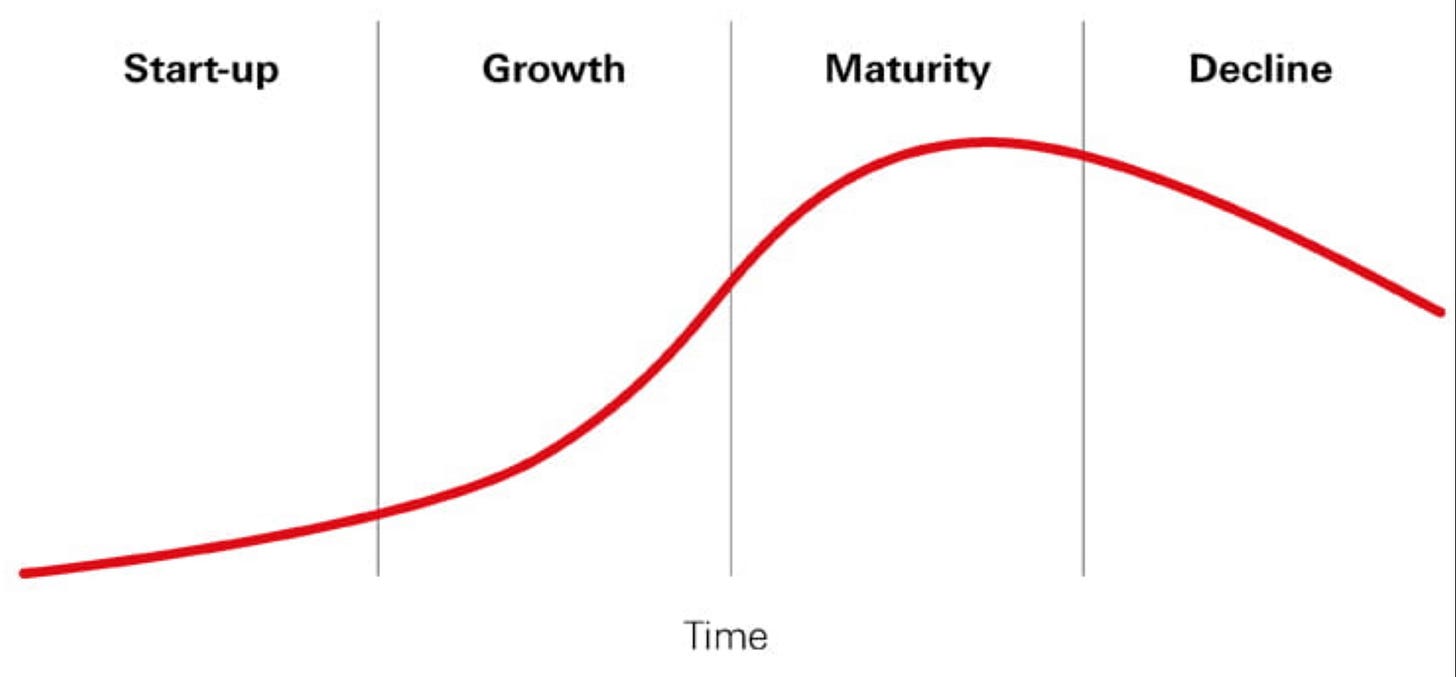Zero to One Careers
Why the backwater is the best place to be
Tech people love to talk about taking companies from zero to one, or building something completely new. Founding or joining a zero-to-one company can be a career-making hack, allowing you to ride a rocket ship to increasing responsibilities at a much faster rate than climbing a lockstep career ladder.
But another career hack—one we don’t talk about nearly enough—is to find a function growing from zero to one. As with building a zero-to-one company, finding a zero-to-one function is a surprisingly hard thing to do, because these fields often look like backwaters at the start. They are the functions without cachet, the things no one wants to do. Only in retrospect is it clear which opportunities were zero to one and which were just…zero.
But if you can find true zero-to-one functions, you can ride the wave of their growth to senior roles much more quickly than if you try to enter well-established fields. Call it reputation arbitrage. Call it disrupting from below. In my experience, this is the best way to build a rewarding, fast-growing career. (And for the entrepreneurs among us, it’s also just way more fun to make the rules than to follow them.)
How to Find a Zero-to-One Function
As with joining a startup, there’s no guarantee that you’ll pick a rocket ship. But there are a few things you can do to improve your odds.
There are two key ingredients to any zero-to-one function:
1. Currently the field is still seen as unsexy, either a necessary evil or an unnecessary frivolity.
This means those more established in their careers don’t think it’s worth their time. (Think digital in 2010 or internal comms pre-COVID.) It’s the thing that gets tossed to the recent grad or even the intern.
If there’s already a lot of competition for the job, it’s no longer in the zero-to-one phase. Sometimes you can catch the beginning of a function going one to n and build a successful career that way, the same way that many people build careers joining growth-stage startups, trading off less risk for more competition.
But be careful not to join a function that’s reached maturity. These are things like becoming a management consultant or a Big Tech PM or a Big Law lawyer. To be clear: There’s nothing wrong with these fields; there’s just no arbitrage to be had here. You’re going to compete on the same terms as everyone else crowding into the application pool, so (a) you better be really really good and (b) you shouldn’t expect outsized rewards. (And if, heaven forbid, you join a field in decline, you’re going to get less in rewards than you bring to the field in credentials.)
2. External factors are conspiring to make the field more important to businesses.
This is the harder piece to predict, but one way to reverse-engineer a hypothesis is to look at what businesses are starting to enter their own zero-to-one phases (or other inflection points) and backing out what they’re missing to succeed.
For example, in the 2010s, startups like Uber and DraftKings operating in highly regulated spaces proliferated. This created a demand for comms pros with a background in politics and regulation, paving the way for a pipeline from the Obama admin to Silicon Valley. This wasn’t necessarily a trend someone like campaign manager David Plouffe could have predicted early enough to build his career around—but when he saw the trend coming, he jumped on it, joining Uber in 2014.
Around the same time, once-scrappy startups like Google and Facebook were becoming riddled with the same bureaucracy and cultural issues of the behemoths they’d sought to disrupt. This led to the a rise in internal dissatisfaction that in turn led to a rise in employee activism—and subsequent need for crisis-minded internal comms guidance.
I was lucky enough to ride both of these trends, moving from politics to tech after Hillary Clinton’s 2016 loss and into internal comms when I joined Palantir in 2019. Of course, you can’t always predict these things, particularly from miles away. But you can develop a spidey sense for when storm clouds are starting to gather in the distance and quickly start to make yourself the expert.
Once you’ve developed a thesis, start testing it out. The good thing is that zero-to-one functions are often the ones that people aren’t territorial about, so you’re likely to hear, “Sure, give it a try,” when you make a suggestion. People don’t yet have fossilized ideas of “best practices” for these fields yet, which means you get to iterate and do crazy stuff and see what spaghetti sticks to the wall and build the plane as you fly it and whatever other overused startup metaphor you want!
A Few Examples
Digital
In college, I read an article about Obama’s sophisticated digital operation in 2012 and thought, I’m already too late. By that point I was a Facebook super-user, an undercover Tumblr-er, a nascent Instagrammer. It seemed so obvious in retrospect that digital was going to change the game. If only I had graduated just a few years earlier, I thought, I could’ve ridden that wave to a pathbreaking career.
Never mind that it’s objectively hilarious to believe yourself to be fatally behind in your career as a 19-year-old. Particularly as a 19-year-old studying political theory, a field that nothing if not proof that flacking is always evolving its form. (What was the Leviathan if not a period-appropriate thought leadership campaign for the English monarchy?)
When I graduated and joined Hillary Clinton’s campaign, I was so jealous of the Digital Team. The Communications and Political and Speechwriting Teams were helmed by longtime politicos, older individuals with storied CVs, but the Digital Communications Team was led by much younger gentleman! By 2016, digital was no longer a backwater; it was an essential part of any communications strategy. People who had spent the first few years of their careers drafting tweets and Facebook posts for no other reason than they were Millennials1 and no one else wanted to do it—those people were suddenly in charge of shit. I felt like I had just missed the boat.
In retrospect, of course, I might not have wanted to get on the boat at all. After all, I’d interned at jobs that threw social media at me because the Olds didn’t want to do it, and I’d resented that. I’d wanted to be where the action was, to be doing something seen as prestigious2—so who’s to say that I wouldn’t have scoffed at digital had I graduated early enough to get on board in the zero-to-one days?
Again, the point is that the future rocket ships don’t look like rocket ships at the start. So lose the ego.
Internal Comms
I joined Palantir amid a flurry of controversy around the company’s government contracts. 2019 was the heart of the Trump administration and protests—against Trump, against corporate sleezeballs, for women, for immigrants—were de rigueur. Protests were just beginning to move inside of companies, too, but only at a select few, Google and Palantir among them.
While at an agency, I had the chance to work on some crises for Unnamed Big Tech Company that I then parlayed into my Palantir interviews. Palantir needed someone who could think end-to-end about crisis response. Someone who could work across media and other forms of content, someone who could consider not just traditional media but also employees and candidates. That was me!
When I started doing this work, most of my non-Palantir friends thought internal comms sounded like the most boring thing in the world. “So you’re, like, communicating about benefits?” they would ask, baffled that I gave up a job that put me in the center of some of the tech world’s spiciest controversies for a field that was still seen mostly as an HR offshoot.3
But fellow Palantirians knew that this crisis was existential for our business. And this experience set me up to be the go-to person when COVID hit and suddenly internal comms became the most important thing in the world for every business, not just Palantir. Finally everyone else saw what I did: that modern internal comms was not a redheaded stepchild but instead a delicate balancing act between crisis and executive comms, a strategic function that deserved a seat at the table.
Current Zero-to-One Opportunities
There are still so many zero-to-one opportunities, especially in comms, the field I know best. Content is perhaps the biggest one: As media outlets continue to shutter, owned channels are becoming an increasingly important way for businesses to reach their audiences.
Another is executive comms, which is booming as the lines behind personal and corporate brands dissolve and communication becomes an increasingly central leadership skill. In fact, I attended a fabulous Executive Communications Masterclass earlier this week that sparked this newsletter. The daylong workshop reminded me that so much of what I like about executive comms is that the rules are still being written, which means there’s a lot of room for innovation.
I suspect there are many other functions are undergoing the same glow-ups; I just don’t know what they are. (If you have thoughts on what I’m missing, please let me know!)
Ah, those were the days, when the Millennials were the disrupters and not the disrupted.
Yes, attending a Very Fancy College can poison your brain.
HR has also had its own glow-up, thanks in large part to these same internal crises and also Google’s former Head of People Lazlo Bock. Bock’s book Work Rules is a delight as well as a useful chronicle of how he joined a backwater field and helped turn it into a strategic engine.



